Best-selling author Michael Lewis has a dirty little secret.
A secret so bad his wife would rather there was a porn video of him circulating the internet than for the world to know the truth.
That secret?
How bad his taste in music really is.
In his new short course, How to Tell a Great Story, on MasterClass.com (my favourite place on the internet), he reveals that he wrote most of The Undoing Project while listening to ‘Let It Go‘ from Frozen on repeat.
That and anything by Taylor Swift.
Maybe his wife was right!
Michael Lewis is the author of numerous best-selling books (Liar’s Poker, Flash Boys, etc.), including three that have been turned into films and subsequently nominated for numerous Oscars:
- Moneyball (6 nominations)
- The Big Short (5 nominations, 1 win)
- The Blind Side (2 nominations, 1 win).
He also runs an excellent podcast called Against The Rules, which I have loved listening to every season. Michael has a great voice to listen to!
“Unless you have a story,
Michael Lewis
you don’t have a way to persuade people.”
Michael Lewis is one of those select authors* whose books I own almost all of, so I was really excited to check out his new course on MasterClass.com. I’ll share my thoughts on the class and some specific lessons film editors can take away from it.
While concise in duration at under two hours, it is packed with valuable narrative wisdom, solid creative advice, and inspiration for anyone who tells stories for a living.
*(Neal Stephenson, Tim Keller, Malcolm Gladwell)
What is MasterClass.com?
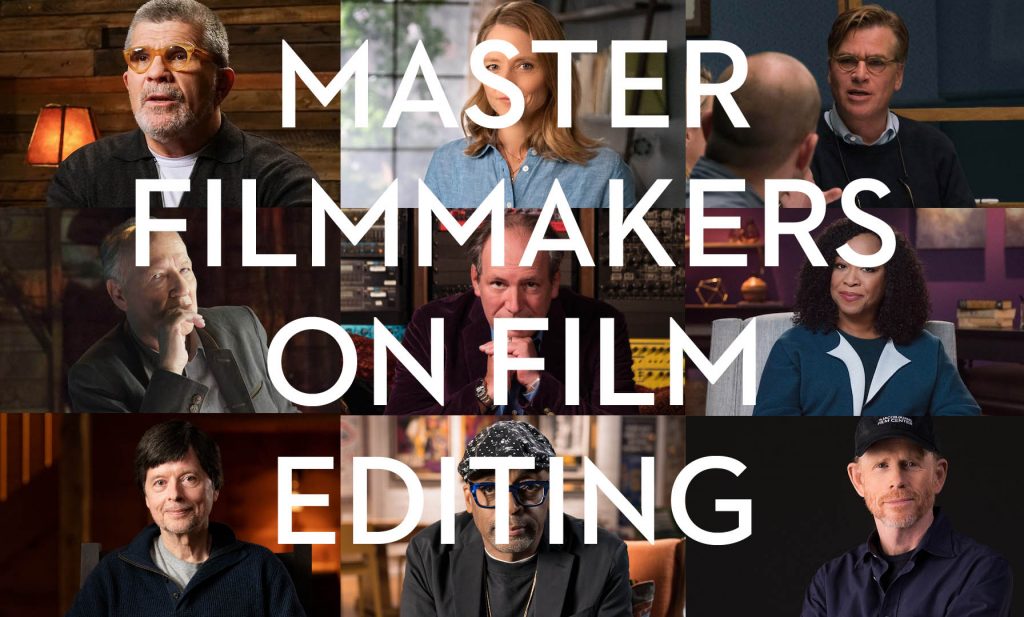
If you’ve not heard of MasterClass.com you’ve been missing out!
It is literally my favourite place on the internet and one of the few places online today where you can learn from the world’s best practitioners in almost any arena: cooking, filmmaking, sport, magic, acting, science, design, advertising, investing, music – you name it!
Each MasterClass is produced to an exceptionally high quality and craft to deepen your knowledge and expertise in a specific topic. I devour a lesson or two most lunchtimes.
MasterClass.com costs just £10 or $10/month when billed annually, on par with many streaming platforms, and features over 200 classes to choose from.
Here are some quick links to my detailed MasterClass Reviews:
- Master Filmmakers on the Craft of Film Editing
- How To Break Into Hollywood with the Creators of Stranger Things
- Ron Howard Directing MasterClass Reviewed
- James Cameron Filmmaking MasterClass Reviewed
- Aaron Sorkin Screenwriting MasterClass Reviewed
- Hans Zimmer Composing MasterClass – An Editor’s Review
- Martin Scorsese Teaches Filmmaking MasterClass Review
- MasterClass.com All-Access Pass Reviewed
- MasterClass courses for Film Editors
- Magic, Movies and the Art of Film Editing
MasterClass.com Discount Code?
Several times a year MasterClass.com offers a 2-4-1 deal where, if you’re feeling generous, you can buy one, gift one of their subscriptions, or if you’re feeling thrifty, you and a friend could split the cost and effectively get MasterClass for 50% off.
One of MasterClass’ longest-running sale periods is from Thanksgiving/Black Friday through Christmas, but they usually offer the same deal around Mother’s Day and Father’s Day.
At their current pricing this means you and a friend could get a year’s subscription to MasterClass for just $60 or, effectively, $5/ month!
If you’re curious, you can learn from anyone
One of the things I most appreciate about being a MasterClass subscription member is that I can learn from any one of the 200+ world-class instructors in their library to enhance my understanding of what I do as an editor, writer, entrepreneur, or parent.
They might be teaching me about the patience and diligence of a 12-hour beef brisket smoke or the intricacies of world-building in game design, but it all goes into my brain and becomes useful fuel for the creative fires within me.
I can’t say when or where it will emerge, but I think part of the process of growing as a creative person is just absorbing as much of the world as you can, and letting those experience permeate your artistic expression.
Michael Lewis – MasterClass.com Course Review
Michael Lewis’s Tell a Great Story on masterClass.com is a compelling way to spend 2 hours and 20 minutes learning from someone who has built an extremely successful career by finding hidden stories and bringing them to the page and screen.
It is broken down into four episodes:
- Stocks, Stats and Finding Your Story – (48:33) – Find your voice, hone an idea and make anything interesting.
- Tackles, Subprimes, Crypto and Premonitions – (49:16) – Strategies for building stories.
- Start to Finish – (32:22) – Creative Routines and crafting the perfect ending.
- Bonus Episode – (10:10) – Why storytelling is a powerful skill in any domain.
Each lesson explores storytelling through the lens of one or two of Michael’s best-selling books and often includes interviews with some of his subjects, such as baseball coach Billy Beane (Brad Pitt in Moneyball) and Charity Dean, MD – former Assistant Director of the California Department for Public Health.
Peppered throughout the class are pearls of writing and general storytelling wisdom that will be invaluable to anyone trying to convince and compel others through narrative.
Which includes film editors, obviously.
“Broadly, what I’m doing as a writer is filtering the world for what’s interesting and then organising what’s interesting into a story.”
Michael Lewis
This process is exactly what editors do.
Our ‘world’ is the footage we have to work with on that particular project and we must filter it for what’s interesting and then structure that material into an interesting story, building the connective tissue as we go.
Listening to Michael discuss the trajectory of his career, share some of his encounters with the real-life characters behind his books and unpack his creative process was both really enjoyable and really helpful.
Create a Space to Create
The key to it all is the feeling of the impossibility of interruption… There’s something about sitting down to write where I need to feel like, this might go on forever.
As someone who gets interrupted a lot, I have to agree that this is one of the best tips to being creatively productive. You need to get into the flow, get lost in the flow and then stay in the flow.
That is all broken by the ping of a notification or a knock at the door.
Therefore to actually achieve a decent amount of creative work, you need to create a secluded private space free from distractions.
This is also where Michael throws on some headphones and blasts ‘Let It Go’ – he likes to listen to really ‘up’ music that makes him feel positive. The walls of his office are plastered with photos of his children, as these remind him of his love for them and that he is loved. Again, putting yourself in a positive place.
Routine – Writing in the same place at the same time and playing the same musical playlists over and over helps Michael to get into the zone and puts him in a positive writing mood. The headphones also help block out any interruptions.
Lastly, he likes to stop before he’s really finished. He makes it easy for himself to get started the next time he comes to write because he already knows exactly where he’s going, so he doesn’t start the day with “2 hours staring at a blank screen.”
A Different MasterClass Format
One thing that I’m sort of undecided about is the new format of some of the MasterClass courses.
Instead of lots of individual lessons that are maybe 5-15 minutes in length with a greater granularity when it comes to contents pages and organisation, the courses content is presented more like a TV show at 30-50 minutes running time.
In some ways this makes it easier to watch, as it moves along in one larger thematic flow per episode. And there are still the chapter markings and animated intertitles that break it up into idea-specific chunks.
But in other ways it makes it feel like you need to carve out a clear thirty to sixty minutes of free time to watch something, rather than opting for a single 15-minute lesson. Although you’ll probably end up watching three or four anyway…
MasterClass AI Teaching Assistant
MasterClass has incorporated an AI chatbot ‘teaching assistant’ that lives in a sidebar that you can show and hide at any time. But, in it’s current implementation at least, it doesn’t seem very useful in terms of interrogating the actual class content.
You can’t say things like “Give me the quote Michael shared about why he doesn’t take notes”, because it doesn’t have access to the transcript of the course, although it can reference some kind of summary notes.
Its current abilities and purpose seem to be to give you access to a chat bot to explore similar ideas, techniques, or topics that might have arisen while watching the lesson. Rather than interacting with the lesson or the instructors take on things.
Maybe I”m using it wrong but I didn’t get a lot of from it. Not in comparison to just taking in the class!
Lessons for Film Editors from Writer Michael Lewis
There is a huge amount of overlap between the craft of writing and the craft of editing.
Why else do you think the edit is called the final re-write?
There’s also a fascinating book called Writing for the Cut, which takes film editing principles and applies them to screenwriting, which helps to show that the crafts cut both ways.
That said, here are some of my favourite takeaways from Michael’s class and how I think they apply to film and video editors today.
Finding Your Voice | Trusting Your Editing Instincts
One of Michael’s core habits is to imagine he’s writing to someone who loves him. He often imagines he’s writing to his mother. By thinking of someone who is going to receive your creative work in the absolute best possible light you can do away with the self-doubt, the second-guessing and self-critique and just do the work.
To me, this is the editor’s equivalent of ‘trusting your gut’. Trusting that your own creative editing instincts are worth relying on and making something you like.
Read It Aloud | Sit In Another Chair
When Michael is editing his own work, he suggests that you read it aloud.
Is it interesting to you? Where is it dull and boring? If you’re not interested, the audience won’t be either.
The editor’s version of ‘read it aloud’ is to sit in a different chair.
Another, more active version of this, is to bring in another person to sit with you while you watch the cut. Even if they don’t say a word, you’ll pick up things in the edit you’ve not seen before.
This will help you stay fresh to your edit. (Here are four more strategies to help with that.)
Storytelling with Index Cards
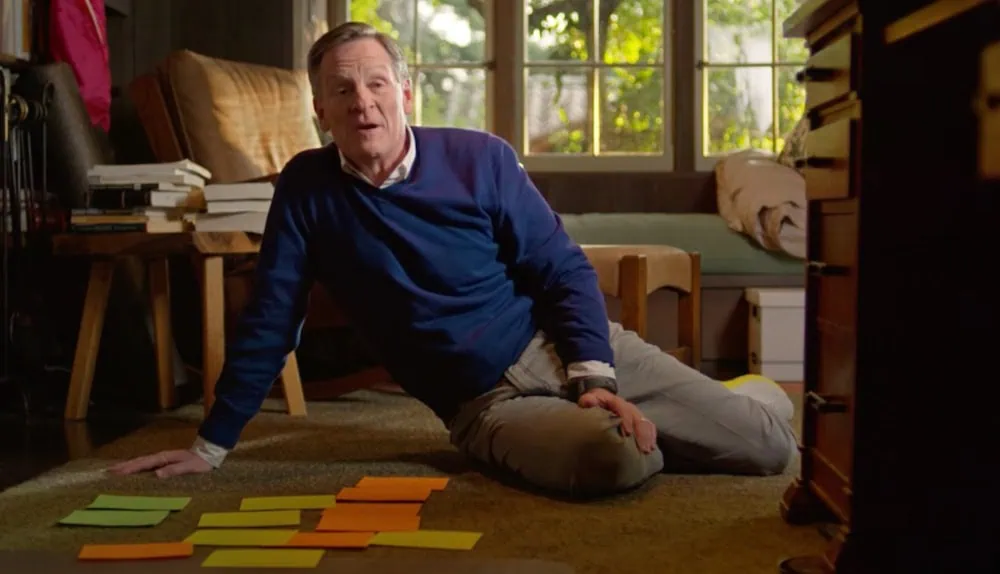
Michael uses 3 colours of index cards to structure and re-order his stories on the floor of his office.
- Orange = Characters/situations
- Yellow = Ideas coming across
- Green = Broader themes.
This is a great way to group and fully grasp all of the ideas, themes and plot points you’re currently trying to weave into the story. Maybe there are too many? Maybe the work better being told in two parallel narratives.
The master of this physicalising of the edit is film Editor Walter Murch.
Theme & Character
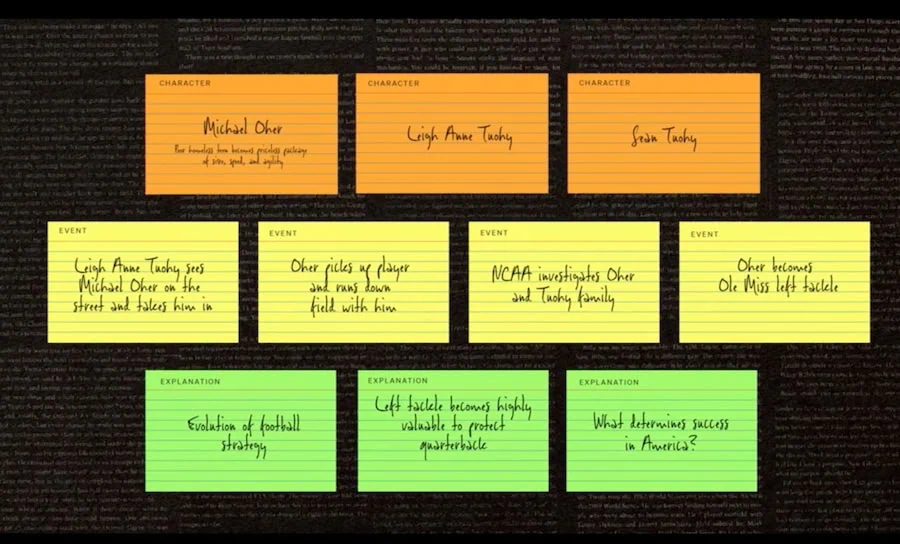
One thing that becomes immediately apparent in reading any of Michael’s best-selling books is that he’s always exploring a larger theme that the characters are a part of.
For example, in The Blindside and Moneyball, the theme is the same while the characters are quite different.
- Undervalued people – Michael Orre
- Overvalued – Billy Beane
- The overarching theme – Changing the system
Therefore, the story follows the characters’ journey while uncovering the system they inhabit and the change they create in the world as a result of their place in that system.
Deeply considering the character arcs and themes at play as you craft your own narrative through your edit will help the whole project gain a greater depth of meaning and purpose.
Compression is Powerful
This is similar to editor Steve Audette’s axiom, “The mind cannot absorb what the butt cannot endure.” The longer the final edit, the harder it will be to engage with.
If in doubt, cut it out.
Michael’s advice:
If you’re going to write a 500-page book, write a 280-page book. If you write a 30-word sentence, write it in 15.
Michael Lewis
If you use a long word, use a shorter version.
Verboisity gets in the way of connecting. Make it punchier.
True in words, true in film.
(Here are 3 techniques from Walter Murch to make your edit shorter.)
The Best Advice Given to a Pulitzer Prize-Winning Writer
Michael’s best creative advice, which he once gave to a Pulitzer prize-winning writer who later said it helped them get through their next book, and it is nothing profound yet it is powerful advice.
“Put your ass in the chair.”
“Don’t walk around. Don’t drink cups of coffee. Don’t talk about why you aren’t writing your book. Just put your ass in the chair.”
Take Michael’s class, Tell a Great Story, on MasterClass.com and enjoy everything he has to share along side the 200+ other world-renown instructors, including filmmakers such as Spike Lee, Martin Scorcese, Ron Howard, Jodie Foster, James Cameron, Werner Herzog, Ken Burns, Aaron Sorkin and Hans Zimmer – to name just a few, for only $10/£10 month (billed annually).
Check out MasterClass.com for yourself, you won’t be disappointed!




